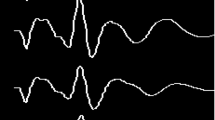Abstract
Objective: To observe the effect of electro-acupuncture (EA) on auto regressive with exogenous input model (ARX-model) auditory evoked index (AAI) in patients anesthetized with different anesthetics.Methods: Forty-eight adult patients undergoing scheduled surgical operation were enrolled and divided into two groups (24 in each group) according to the anesthetics applied, Group A was anesthetized with propofol sedation and Group B with Isoflurane-epidural anesthesia. Group A was subdivided into three groups of low, middle and high concentration of target effect-site of 1.0 μg/ml, 1.5 ug/ml and 2.0 μg/ml through target controlled infusion (TCI) and Group B into 3 subgroups of minimum alveolar effective concentration of isoflurane (0.4 MAC, 0.6 MAC and 0.8 MAC for B1, B2 and B3 subgroups) respectively, with 8 patients in every subgroup. EA on acupoints of Hegu (LI4) and Neiguan (P6) was applied on all the patients during anesthesia, and the change of AAI at various time points was recorded.Results: In the three subgroups of Group A, levels of AAI were significantly elevated in the first few minutes after EA, and significantly lowered 20 min after EA in subgroup A2. While in the subgroups of Group B, except the elevating in Group B1 1 – 2 min after EA, levels of AAI remained unchanged at other time points.Conclusion: Pain response could be reflected by AAI during EA. EA could enhance the sedative effect of propofol in middle concentration, but its effect on isoflurane epidural anesthesia is insignificant.
Similar content being viewed by others
References
Thornton C, Sharpe RM. Evoked responses in anaesthesia. Br J Anaesth 1998; 81: 771–781.
Mantzaridis H, Kenny GN. Auditory evoked potential index: a quantitative measure of changes in auditory evoked potentials during general anaesthesia. Anaesthesia 1997; 52: 1030–1036.
Urhonen E, Jensen EW, Lund J. Changes in rapidly extracted auditory evoked potentials during tracheal intubation. Acta Anaesthesiol Scand 2000; 44: 743–748.
Davies PW, Mantzaridis H, Kenny GN, et al. Middle latency auditory evoked potentials during repeated transitions from consciousness to unconsciousness. Anaesthesia 1996; 51: 107–113.
Gaj Raj RJ, Doi M, Mautzaridis H, et al. Comparison of Bispectral EEG analysis and auditory evoked response for monitoring depth of anaesthesia during propofol anaesthesia. Br J Anaesth 1999; 82: 672–678.
Gaj Raj RJ, Doi M, Mantzaridis H, et al. Analysis of the EEG bispectrum, auditory evoked potentials and the EEG power spectrum during repeated transitions from consciousness to unconsciousness. Br J Anaesth 1998; 80: 46–52.
Ge SJ, Zhuang XL, Wang YT, et al. Changes in the rapidly extracted auditory evoked potentials index and the bispectral index during sedation induced by propofol or midazolam under epidural block. Br J Anaesth 2002;89: 260–264.
Han JZ. Exploration into mechanism of acupuncture anesthesia based on molecular physiology. Jiangsu J Tradit Chin Med 2002; 23(3): 27–28.
Katoh T, Suzuki A, Ikeda K. Electroencephalographic derivatives as a tool for predicting the depth of the sedation and anesthesia induced by sevoflurane. Anesthesiology 1998; 88: 642–650.
Zhu LY. Chinese electro-acupuncture. Xran: Shaanxi Science and Technology Press, 1983: 70.
Author information
Authors and Affiliations
Corresponding author
Rights and permissions
About this article
Cite this article
Li, L., Sheng-jin, G. & Zhang-gang, X. Clinical study on effect of electro-acupuncture combined with different anesthetics on auditory-evoked potential index. Chin. J. Integr. Med. 12, 1–5 (2006). https://doi.org/10.1007/BF02857421
Received:
Issue Date:
DOI: https://doi.org/10.1007/BF02857421




